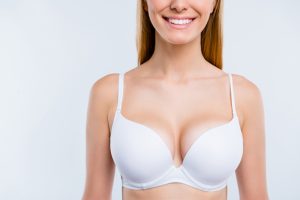
Breast Implants | Breast Augmentation
Breast augmentation is one of the most frequently performed cosmetic surgery procedures at the Plastic Surgery Institute of Atlanta. Breast augmentation gives women with small or unevenly sized breasts a fuller, firmer, better-proportioned look through placement of saline or silicone gel implants.
Our patients elect to undergo breast augmentation for many different medical and aesthetic reasons, including balancing breast size, compensating for reduced breast mass after pregnancy or surgery, and correcting a congenital breast defect. Under Dr. McCluskey’s care patients enjoy great looking, natural feeling breasts that are one or more cup sizes larger after the operation.
Fully Customized Breast Enhancement
Every patient has unique desires and expectations. Dr. McCluskey takes a great deal of time during pre-operative consultations to learn what each patient hopes to gain from breast augmentation surgery and to decide which implant type & size is best. In this way, every one of our patients enjoys completely customized, individualized treatment designed with her specific goals in mind.
Complementary Procedures
Depending on various factors the total operative time for a typical breast augmentation is 30-60 minutes. Therefore breast augmentation can safely be performed in conjunction with other cosmetic surgery or non-invasive procedures. We sometimes recommend combining breast augmentation with other procedures such as a breast lift, tummy tuck, or liposuction.
Saline & Silicone Breast Implants
Breast implants consist of silicone shells filled with either saline (salt water) or silicone gel. Both implant types are very safe, and each offers its own advantages. Dr. McCluskey will show you both types of implants and help you decide which kind is right for you. Generally when placed under the pectoral muscle both implant types look exactly the same. Many patients agree that silicone gel breast implants feel more like natural breast tissue. Some patients with saline breast implants can feel and see ripples in the implants. Dr. McCluskey commonly performs an implant exchange in these patients by removing the saline implants and replacing them with silicone gel implants. This exchange often resolves the issues & concerns with rippling.
Dr. McCluskey is often asked to address the relative safety of the two types of implants. The most common question patients raise pertains to what happens if one of the implants breasks (ruptures). A saline filled breast implant will essentially deflate if it ruptures or leaks. The saline will harmlessly dissolve into the body from the breast capsule and an implant exchange for saline or silicone gel implants is indicated.
If a silicone gel implant breaks, the gel will remain within the capsule of the breast. Much like a ruptured saline implant, the gel implant will need to be replaced and this is also covered by a warranty from the breast implant manufacturer.
Breast Augmentation Surgery – Incision Techniques
Breast augmentation surgery lasts between 30 minutes and one hour and is typically performed under general anesthesia. Incisions are made in inconspicuous places on the breast to minimize scar visibility. These may be located in the following locations:
- In the under-arm (transaxillary
- In the crease on the underside of the breast (inframammary)
- Around the areola, the dark skin around the nipple (periareolar)
Once the incision is created the breast is lifted, creating a pocket into which the implant is inserted. Saline implants may also be placed endoscopically through an incision in the navel. This minimally invasive breast enhancement technique is known as a transumbilical breast augmentation or TUBA approach. Dr. McCluskey does not use the TUBA approach.
At the Plastic Surgery Institute of Atlanta, Dr. McCluskey primarily uses the transaxillary and the inframammary approaches. In a patient with minimal breast ptosis (droop), the transaxillary incision works nicely for placement of saline implants.
Dr. McCluskey prefers the inframammary approach for placement of gel implants. This incision also works well for patients with mild to moderate breast ptosis.
Breast Augmentation Surgery – Placement Options
Placing the breast implant beneath the pectoralis major muscle of the chest (submuscular) offers a few advantages over placement beneath the breast tissue only (subglandular). Submuscular placement reduces the risk of capsular contracture (post-operative scar tissue and tightening around the implant) and does not interfere with mammogram examinations.
When Dr. McCluskey refers to the pocket, he is referring to the potential space beneath the chest muscle. During surgery the muscle is gently elevated away from the underlying chest wall creating a space for the implant. The implants are then inserted through the incision and positioned correctly. The incisions are sutured closed with dissolving sutures placed beneath the skin. The incision is then taped and bandaged. The bandages may be removed after 12-24 hours but the steri-strips over the incisions are to remain in place until the first postoperative appointment with Dr. McCluskey.
Recovery
Most patients feel tired and sore after breast augmentation surgery, but this usually passes in a day or two. Most patients return to work within the week. Because the sutures that Dr. McCluskey places are dissolvable they do not need to be removed after breast augmentation. Any post-operative pain, swelling and sensitivity will diminish over the first few weeks.
Scars from breast augmentation incisions will begin to fade in a few months and will continue to fade for months or years. During the first few days after surgery the implants may appear very high on the chest. This happens because the chest muscle tightens around the implant and pulls it upward. As the muscle relaxes the implants will “drop” and assume a more natural position and appearance.
